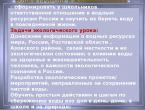The importance of water in human life presentation. The role of water in nature and human life. There is no way to keep up with a motor boat
To use presentation previews, create a Google account and log in to it: https://accounts.google.com
Slide captions:
PROJECT TOPIC: “WATER IN HUMAN LIFE” Secondary group teacher of GBDOU No. 131 Irina Leonidovna Sherstneva
Project type: informational, educational. Project participants: teachers, children, parents. Project duration: 1 month. Project objectives: To give children a reliable understanding of the importance of water in the life of all living things. Generate interest in this problem. Fostering an active attitude towards life around you. Promote intellectual development
Expected results: Developing skills of caring for nature, in particular water, and interest in the future. The desire to learn new things. Creation of a poster-collage “Water in human life.” Find out the properties of water. Preliminary work: Selection of illustrations, literature on the topic. Selection of material for the experiment - properties of water. Experience - the plant wants to drink. Involve parents in finding pictures about water for a collage.
Plan of activities: Reading poems and nursery rhymes about water. Reading the fairy tale “Koska the Hare and Rodnichek” Activity “Who needs water.” Conversation about caring for water. Experiments with water (properties of water). What types of water are there (ice - water - steam). Riddles about water. Making a collage. Invite parents to visit the water museum with their children. TRIZ “What will happen if there is no water?”
The journey of a droplet Where does the water in the tap come from? From the river! The droplets floated in the river, then the man directed them into the pipes. You need to treat water with care, do not leave taps open unnecessarily!
Let's find out the properties of water.
Collage “Water in human life.”
WE MUST SAVE WATER!
Water is the source of life!
On the topic: methodological developments, presentations and notes
Methodological development in the form of a business game "Art in Human Life"
To systematize the knowledge of teachers about the means, methods and techniques of aesthetic education of preschoolers. Develop the ability to find pedagogically correct solutions to problem situations. Develop fan...
Essay “Science is the most important, the most beautiful and necessary in a person’s life, it has always been and will be the highest manifestation of love, only with it alone will a person conquer nature and himself”
Physical education is the basis of great sport, the science of joy, knowledge of yourself, your body and the foundation for the further development of a strong and healthy child....
Presentation on the topic:
The role of water in nature and human life
Water is the source of life, Source of bright days. Look immaculate Into a rushing stream. Everyone wants to get drunk Take care of the rivers Lakes, oceans And small ponds.


Waterfall
Where is water found on Earth? Water is a unique wealth of living nature. It is difficult to find a place on our planet where there is no water.
Ocean
Sea



- Water is a liquid.
- Clean water is clear. If we put a spoon in a glass of water, we can easily see it. The water is colorless.
- Water has no smell.
- Many substances dissolve in water.
- When heated, water expands and when cooled, it contracts.
- When heated to 100 degrees, water turns into steam.

Three states of water
Solid Liquid Gaseous
Ice, snow, hail. Water Steam

The meaning of water in nature
Water is the most common substance on Earth. According to evolutionary theory, life on Earth originated in water. In nature, water plays a vital role. Water is the habitat of many plants and animals.


Water cycle in nature
The importance of the water cycle in nature is simply enormous. It is this process that allows animals and plants to receive the moisture so necessary for their life and existence.




Water pollution
Water pollution is the process of saturating water bodies with harmful substances, industrial waste and household waste, as a result of which water loses most of its functions and becomes unsuitable for further consumption.
- Main sources of pollution:
- Oil refineries
- Heavy metals
- Radioactive elements
- Pesticide
- Effluent from city sewers and livestock farms.
- Household waste


Slide 2
Water, you have no taste, no color, no smell, you cannot be described, they enjoy you without knowing what you are! It cannot be said that you are necessary for life! You are life itself! You fill us with joy that cannot be explained by our feelings... You are the greatest wealth in the world..." Antoine de Saint-Exupéry
Slide 3
STRUCTURE OF A WATER MOLECULE. A WATER MOLECULE CONSISTS OF 2 HYDROGEN ATOMS AND 1 OXYGEN ATOMS, WHICH ARE AT AN ANGLE OF 105° RELATIVE TO EACH OTHER
Slide 4
PHYSICAL PROPERTIES OF H2O At t≥0 At t=100 At t≤0
Slide 5
hydrosphere fresh water salt water water in the atmosphere 4% 95% 1%
Slide 6
water land Glaciers Groundwater Lakes Rivers Swamps 49% 47% 1% 1% 1%
Slide 7
Diagram of the World Water Cycle
Slide 8
Baikal. Wooded mountains are semi-ovals, The touch of blue patterns And rocks cut by a shaft, And the sky that has fallen into Baikal. And he himself is majestic and eternal In a carved granite frame, And all - to the bottom - translucent, And all - down to the drop - dear. And the Hangars fly obstinately, And the scream of the wind, and the hum of the turbines, And the pine birds over the cliff, And the wild wind of the Barguzin. All this, without which you cannot be distant, distant and wide, and you are unthinkable, Russia, and you are unthinkable, Siberia.
Slide 9
Decomposition (electrolysis) of water
Slide 10
Heavy water slows down the vital functions of the growth and development of many microorganisms. Some bacteria tolerate 70% or higher concentrations of heavy water in the environment, while plant cells can develop normally at heavy water concentrations of no more than 50-75%, and animal cells with no more than 35% heavy water
Slide 11
The Volga is a river in the European part of Russia, one of the largest rivers on the globe and the largest in Europe. The length of the river is 3530 kilometers (before the construction of reservoirs - 3690 kilometers).
Slide 12
Currently, about 45% of industrial and approximately 50% of agricultural production in Russia is concentrated in the Volga basin. Of the 100 cities in the country with the most polluted atmosphere, 65 are located in the Volga basin. The volume of contaminated wastewater discharged into the region's basins is 38% of the total Russian total.
Slide 13
Water is the most important substance found in living organisms. What kind of water do we drink? Questions: -Have you ever thought about what kind of water you drink? -Why do you need to boil water? . In water supply laboratories, microbiologists conduct daily water monitoring. The number of microbes in water after special treatment decreases sharply. For example, a study of water in one of these laboratories showed that there were 5639 bacteria in 1 ml cubic meter of river water; after passing water through the sump in the same volume, 138 bacteria were found, and after filtering - only 17 bacteria
Slide 14
arsenic 27 cadmium 0.5 chromium 75 mercury 0.1 lead 18 cobalt 20 iron 4 copper 40 zinc 90 nickel 50 Content of heavy metals and arsenic in bottom sediments of the Volga in%
Slide 15
Slide 16
PHYSICAL PROPERTIES OF WATER. PURE (DISTILLED) WATER IS A COLORLESS LIQUID, WITHOUT ODOR AND TASTE, THE ONLY SUBSTANCE THAT EXISTS ON EARTH IN THREE STATES OF AGGREGATE BOILING POINT 100°C CRYSTALLIZATION (MELTING) POINT 0°C
Slide 17
CHEMICAL PROPERTIES OF WATER. 1. WITH METALS. a) very active metals, when interacting with water, form hydroxide and hydrogen 2Na + 2H2O = 2K + 2H2O = Ca + 2H2O =
Slide 18
b) medium-active metals, when interacting with water when heated, form metal oxide and hydrogen Zn + H2O = c) low-active metals do not react with water
Slide 19
2. WITH OXIDES. a) metal oxides, when interacting with water, form hydroxides CaO + H2O = b) non-metal oxides, when interacting with water, form acids SO3 + H2O =
Slide 20
In third world countries, only one person in five can drink clean, fresh water. - 470 million people on the planet experience acute water shortages - 22 million children die every year from lack and excessive pollution of water. Water shortage on the planet
Slide 21
80% 90% How much water is in living organisms?
Slide 22
The importance of water for humans
In the human body, water: moisturizes oxygen for breathing; regulates body temperature; helps the body absorb nutrients; protects vital organs; lubricates joints; helps convert food into energy; participates in metabolism; removes various wastes from the body. For normal operation of all systems, a person needs at least 2 liters of water per day. Without water, death will occur in 5 days.
Slide 23
Application of water
The industry of our country consumes as much water every second as the Volga carries it. To produce 1 ton of steel, 150 tons of water are consumed, paper - 250 tons, synthetic fibers - 4000 tons. Many chemical processes are accelerated in the presence of water, i.e. water plays the role of a catalyst. But water directly takes an active part in reactions, for example, in the production of acids, slaking of lime, and in hydration processes. Water is required for the processes of setting and hardening of binders - cement, gypsum, lime.
Slide 24
Popular wisdom says: the first bread is bread, the second bread is spirit, the third bread is water. Water protection
Slide 25
Measures to protect water bodies
Monitoring the level of water pollution. Installation of treatment facilities at enterprises; Saving water (turn off the tap, reduce the pressure when you wash your face, brush your teeth, wash dishes, etc.) Planting and protecting plants along the banks of reservoirs. Rational environmental management; Creation of protected areas.
Slide 26
Conclusions:
got acquainted with the physical and chemical properties of water and its composition; gained knowledge about water as the most widespread substance on Earth, identified economic and environmental problems of our time associated with water shortage and pollution through the example of studying the Volga River and Lake Baikal, revealed the role of water in nature and human life, ways of rational use of water resources.
Slide 27
Homework
Homework of your choice: 1) write an essay “The role of water in nature” 2) do a crossword puzzle on the topic “Water” 3) come up with a fairy tale about water What substances does water interact with?
View all slides




